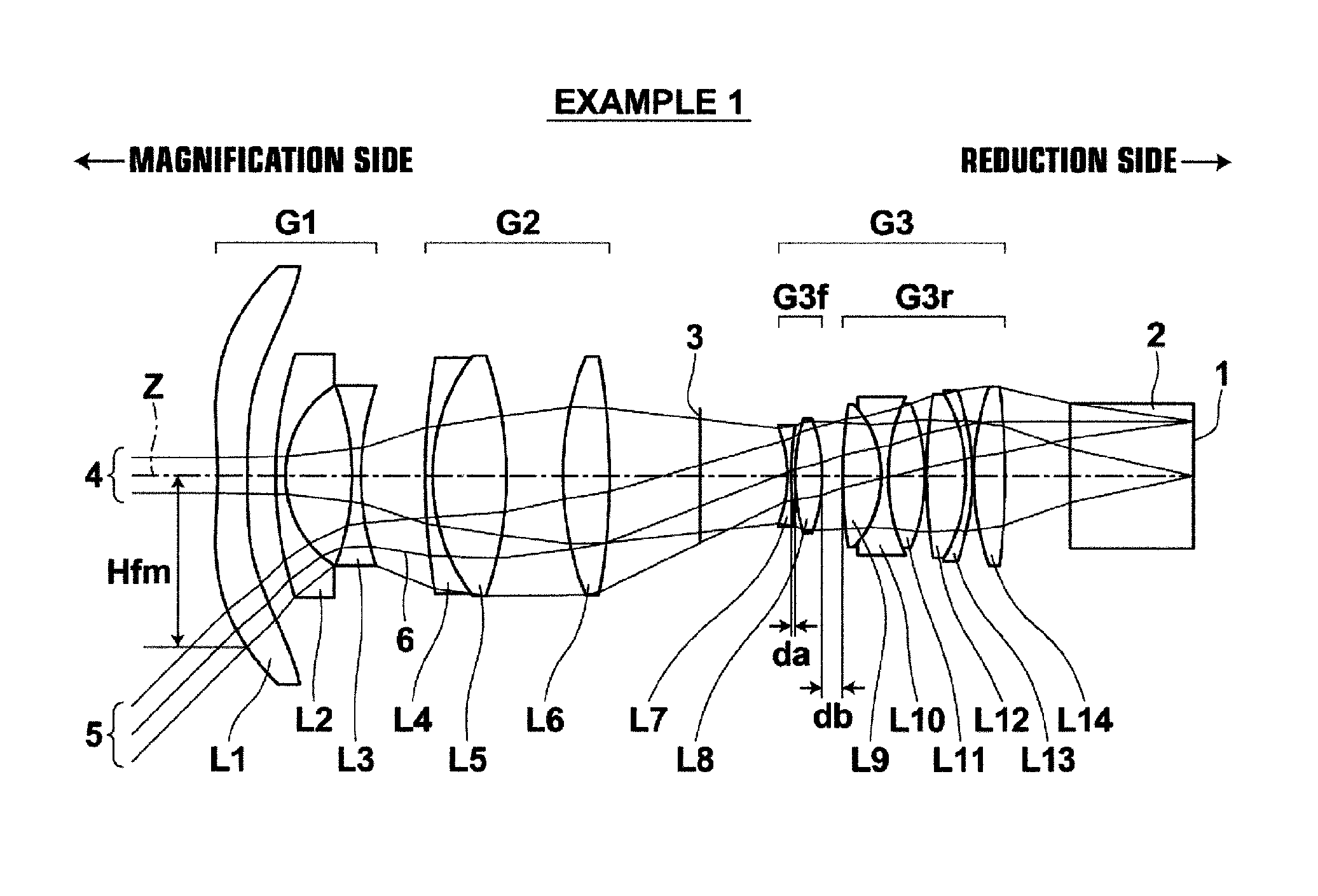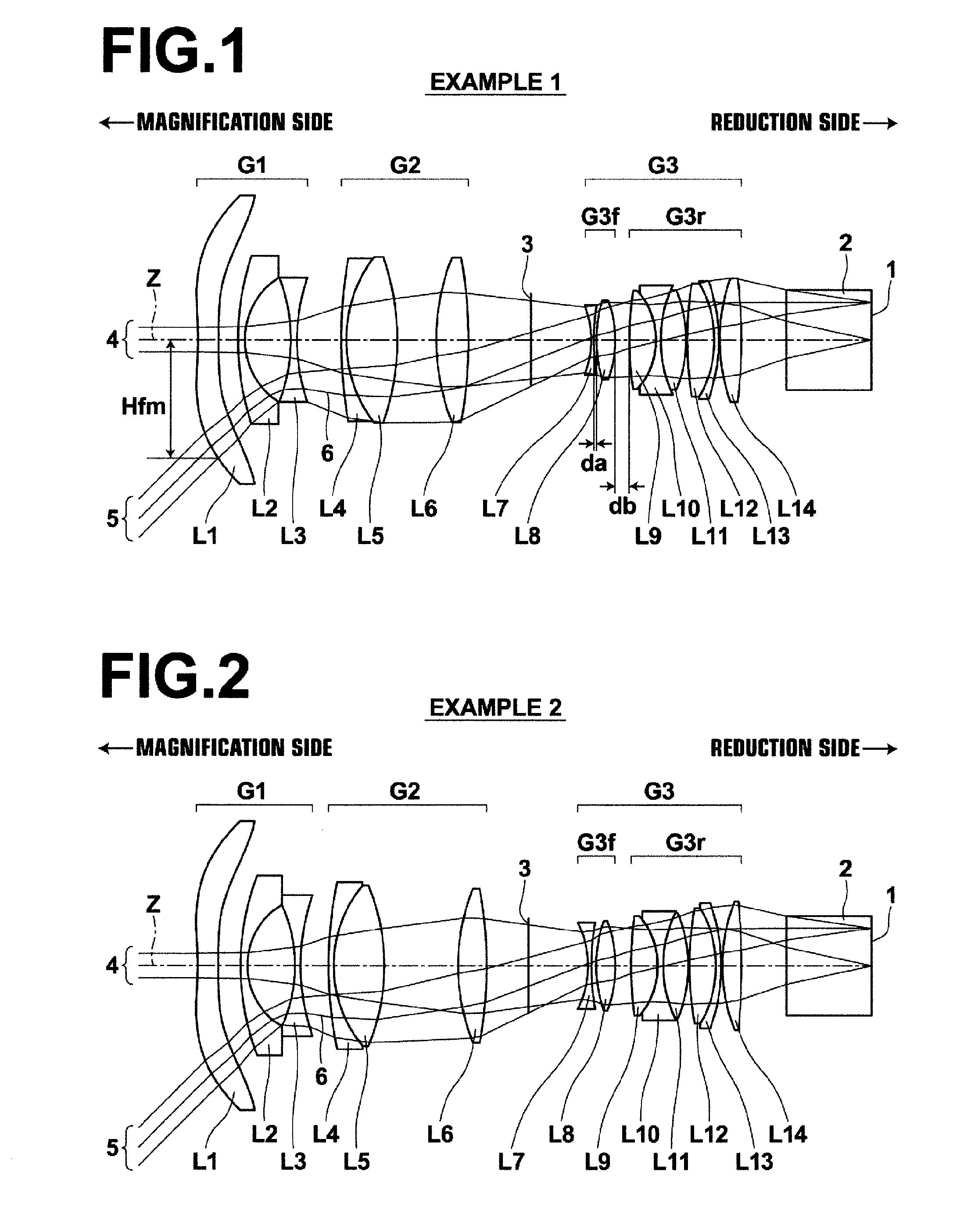Lens for projection and projection-type display apparatus
a technology of projection and display apparatus, applied in the field of projection and can solve problems such as the risk of deterioration of lens performance, and achieve the effects of excellent optical performance, small size of projection type display apparatus, and high brightness
- Summary
- Abstract
- Description
- Claims
- Application Information
AI Technical Summary
Benefits of technology
Problems solved by technology
Method used
Image
Examples
example 1
[0152]A lens structure diagram of a lens for projection in Example 1 and paths of rays are illustrated in FIG. 1. Since FIG. 1 has been described already, repetition of explanation will be omitted. FIG. 1 illustrates structure when projection distance is infinity.
[0153]The lens for projection in Example 1 has three group structure, in which first lens group G1 having negative refractive power, second lens group G2 having positive refractive power, and third lens group G3 having positive refractive power are arranged in this order from the magnification side. Further, the reduction side is telecentric. A glass block 2, which is assumed to be various kinds of filter, such as an infrared-ray-cut filter and a low-pass filter, a color combination prism and the like, is arranged toward the reduction side of third lens group G3. Further, an image display surface 1 of the light valve is arranged in contact with the reduction-side surface of the glass block 2. Further, an aperture 3 consisti...
example 2
[0172]FIG. 2 illustrates the lens structure of a lens for projection in Example 2 and paths of rays. The lens for projection in Example 2 has almost similar structure to the lens for projection in Example 1. Further, lenses that move during focusing are also similar. Table 4, Table 5 and Table 6 show basic lens data, variable surface distances, and aspherical surface coefficients, respectively, about the lens for projection in Example 2. FIG. 11, Sections A through H illustrate aberration diagrams of the lens for projection in Example 2. In the data about Example 2, projection distance is 123.93 when projection distance is finite distance. At this projection distance, the focal length of the entire system is 1.002, and an F-number is 1.70, and a full angle of view is 84.2°.
TABLE 4EXAMPLE 2 BASIC LENS DATASiRiDiNdjν dj*1−5.53130.54221.4910057.58*2−32.4926DD[2]35.68880.17821.6180063.3341.63011.26145−3.22950.14921.7725049.6064.8073DD[6]79.08920.13671.7552027.5182.84971.32791.7015441.24...
example 3
[0173]FIG. 3 illustrates the lens structure of a lens for projection in Example 3 and paths of rays. The lens for projection in Example 3 has almost similar structure to the lens for projection in Example 1. Further, lenses that move during focusing are also similar. Table 7, Table 8 and Table 9 show basic lens data, variable surface distances, and aspherical surface coefficients, respectively, about the lens for projection in Example 3. FIG. 12, Sections A through H illustrate aberration diagrams of the lens for projection in Example 3. In the data about Example 3, projection distance is 124.13 when projection distance is finite distance. At this projection distance, the focal length of the entire system is 1.003, and an F-number is 1.80, and a full angle of view is 79.0°.
TABLE 7EXAMPLE 3 BASIC LENS DATASiRiDiNdjν dj*1−3.22300.54311.4910057.58*2−4.8199DD[2]37.53800.17841.5891361.1441.71271.09285−3.40200.14731.7725049.6063.6823DD[6]710.19630.13261.7552027.5183.03541.30211.7015441.24...
PUM
 Login to View More
Login to View More Abstract
Description
Claims
Application Information
 Login to View More
Login to View More - R&D
- Intellectual Property
- Life Sciences
- Materials
- Tech Scout
- Unparalleled Data Quality
- Higher Quality Content
- 60% Fewer Hallucinations
Browse by: Latest US Patents, China's latest patents, Technical Efficacy Thesaurus, Application Domain, Technology Topic, Popular Technical Reports.
© 2025 PatSnap. All rights reserved.Legal|Privacy policy|Modern Slavery Act Transparency Statement|Sitemap|About US| Contact US: help@patsnap.com



